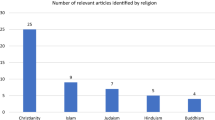Abstract
I assess the ethical content of Philip Roth's account of his father's final years with, and death from, a tumor. I apply this to criticisms of the nature and content of case reports in medicine. I also draw some implications about modernism, postmodernism and narrative understandings.
Similar content being viewed by others
References
Roth P.Patrimony. New York: Touchstone, 1991. A version of the last chapter appeared as “The Last Days of Herman Roth” inThe New York Times Magazine December 30, 1990, pp 17–19, 22. It provides a few further facts.
Poirier S, Brauner DJ. Ethics and the daily language of medical discourse.Hastings Center Report August/September 1988;18:5–9.
Donnelly WJ. Righting the medical record.JAMA 1988;260:823–825.
Kopelman LM. Case method and casuistry: the problem of bias.Theor Med 1994;15:21–37.
I should eventually distinguish cases from narratives from stories; Hunter seems to do this, though differently from the way I tacitly approach it. See, Hunter KM.Doctors' Stories: The Narrative Structure of Medical Knowledge. Princeton: Princeton University Press, 1991.
Postmodernism is like a metropolis of many suburbs and subdivisions. One helpful guide is Turner BS. (ed.)Theories of Modernity and Postmodernity. London: SAGE Publications, 1990.
Consider the ageism in the responses to and neglect of Herman's hearing loss and facial droop. See Erde EL, Eden A. Ethics and the care of persons with Bell's Palsy.Social Science and Medicine 1991;32:559–563.
See the episode in which Philip deceives a taxi-driver into thinking he is a doctor as an example of a deception for non-paternalistic purposes [Roth: 91, pp. 153–160].
Bok S.Lying: Moral Choice in Public and Private Life. New York: Pantheon, 1978.
I mean much of this to be a methodological discussion as sketched in Erde EL. Method and methodology in medical ethics: Inaugurating another new section.Theor Med. This issue pp 235–238.
Indeed,narrative may not be an idea unified enough to do what is asked of it. Its breadth is broad enough to make its application tautologous and its components are diverse enough to make it self-contradictory. See Hauerwas S, Jones LG.Why Narrative?: Readings in Narrative Theology. Grand Rapids Mich: William B. Eerdmans Pub. Co., 1989. Important work in medical humanities focused by stories has been done by Hunter ibid.: 91, Brody H.Stories of Sickness. New Haven: Yale University Press, 1987, and Kleinman A.The Illness Narratives: Suffering, Healing and the Human Condition. New York: Basic Books, 1988.
“The absurd” is one reaction to the loss. Camus A.The Myth of Sisyphus and Other Essays. New York: Vintage, 1955.
Kuhn T.Structures of Scientific Revolutions, 2d ed. Chicago: University of Chicago Press, 1970. For a critique of Kuhn see, Lakatos I, Musgrave A. (eds)Criticism and the Growth of Knowledge. Cambridge: Cambridge University Press, 1970. Beyond, or earlier than, Kuhn see Sleeper R.The Necessity of Pragmatism: John Dewey's Conception of Philosophy. New Haven: Yale University Press, 1986 on Dewey. I believe that the later Wittgenstein also fits here.
However, many argue that ancients such as Plato and early Judeo-Christian storytellers insights tied to the nature of narrative. See Hauerwas and Jones, ibid.: 89. One way I understand narratives' advantages is to liken narrative to film — in which motion and articulation are built in — in contrast with photographs.
Bosk CL.Forgive and Remember: Managing Medical Failure. Chicago: Chicago University Press, 1979 shows how horror stories are a major medium of teaching norms to surgical residents. Moreover, beyond ethics, the role of narrative in discovery, explanation and knowledge holds for many fields. See Polkinghorne DE.Narrative Knowing and the Human Sciences. Albany: SUNY Press, 1988.
Author information
Authors and Affiliations
Additional information
A version of the first two sections of this paper was presented at the annual meeting of the Society for Health and Human Values November 6, 1993, Washington, D.C.
Rights and permissions
About this article
Cite this article
Erde, E.L. Philip Roth'sPatrimony: Narrative and ethics in a case study. Theor Med Bioeth 16, 239–252 (1995). https://doi.org/10.1007/BF00998143
Issue Date:
DOI: https://doi.org/10.1007/BF00998143




